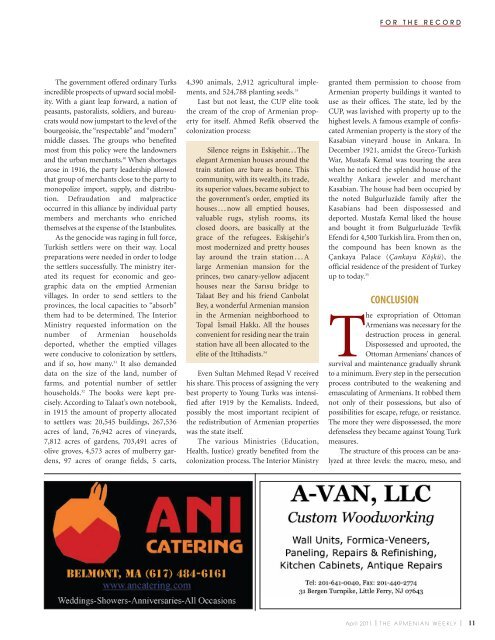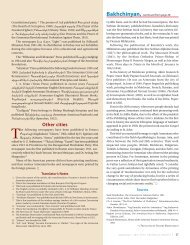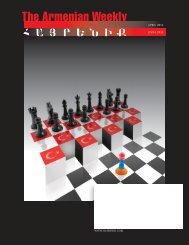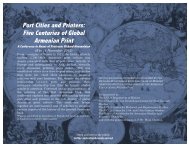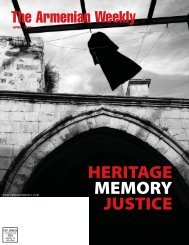Armenian Weekly April 2011 Magazine
Armenian Weekly April 2011 Magazine
Armenian Weekly April 2011 Magazine
Create successful ePaper yourself
Turn your PDF publications into a flip-book with our unique Google optimized e-Paper software.
FOR THE RECORDThe government offered ordinary Turksincredible prospects of upward social mobility.With a giant leap forward, a nation ofpeasants, pastoralists, soldiers, and bureaucratswould now jumpstart to the level of thebourgeoisie, the “respectable” and “modern”middle classes. The groups who benefitedmost from this policy were the landownersand the urban merchants. 30 When shortagesarose in 1916, the party leadership allowedthat group of merchants close to the party tomonopolize import, supply, and distribution.Defrauda tion and malpracticeoccurred in this alliance by individual partymembers and merchants who enrichedthemselves at the expense of the Istanbulites.As the genocide was raging in full force,Turkish settlers were on their way. Localpreparations were needed in order to lodgethe settlers successfully. The ministry iteratedits request for economic and geographicdata on the emptied <strong>Armenian</strong>villages. In order to send settlers to theprovinces, the local capacities to “absorb”them had to be determined. The InteriorMinistry requested information on thenumber of <strong>Armenian</strong> householdsdeported, whether the emptied villageswere conducive to colonization by settlers,and if so, how many. 31 It also demandeddata on the size of the land, number offarms, and potential number of settlerhouseholds. 32 The books were kept precisely.According to Talaat’s own notebook,in 1915 the amount of property allocatedto settlers was: 20,545 buildings, 267,536acres of land, 76,942 acres of vineyards,7,812 acres of gardens, 703,491 acres ofolive groves, 4,573 acres of mulberry gardens,97 acres of orange fields, 5 carts,4,390 animals, 2,912 agricultural implements,and 524,788 planting seeds. 33Last but not least, the CUP elite tookthe cream of the crop of <strong>Armenian</strong> propertyfor itself. Ahmed Refik observed thecolonization process:Silence reigns in Eskişehir...Theelegant <strong>Armenian</strong> houses around thetrain station are bare as bone. Thiscommunity, with its wealth, its trade,its superior values, became subject tothe government’s order, emptied itshouses...now all emptied houses,valuable rugs, stylish rooms, itsclosed doors, are basically at thegrace of the refugees. Eskişehir’smost modernized and pretty houseslay around the train station...Alarge <strong>Armenian</strong> mansion for theprinces, two canary-yellow adjacenthouses near the Sarısu bridge toTalaat Bey and his friend CanbolatBey, a wonderful <strong>Armenian</strong> mansionin the <strong>Armenian</strong> neighborhood toTopal İsmail Hakkı. All the housesconvenient for residing near the trainstation have all been allocated to theelite of the Ittihadists. 34Even Sultan Mehmed Reşad V receivedhis share. This process of assigning the verybest property to Young Turks was intensifiedafter 1919 by the Kemalists. Indeed,possibly the most important recipient ofthe redistribution of <strong>Armenian</strong> propertieswas the state itself.The various Ministries (Education,Health, Justice) greatly benefited from thecolonization process. The Interior Ministrygranted them permission to choose from<strong>Armenian</strong> property buildings it wanted touse as their offices. The state, led by theCUP, was lavished with property up to thehighest levels. A famous example of confiscated<strong>Armenian</strong> property is the story of theKasabian vineyard house in Ankara. InDecember 1921, amidst the Greco-TurkishWar, Mustafa Kemal was touring the areawhen he noticed the splendid house of thewealthy Ankara jeweler and merchantKasabian. The house had been occupied bythe noted Bulgurluzâde family after theKasabians had been dispossessed anddeported. Mustafa Kemal liked the houseand bought it from Bulgurluzâde TevfikEfendi for 4,500 Turkish lira. From then on,the compound has been known as theÇankaya Palace (Çankaya Köşkü), theofficial residence of the president of Turkeyup to today. 35 CONCLUSIONThe expropriation of Ottoman<strong>Armenian</strong>s was necessary for thedestruction process in general.Dispossessed and up rooted, theOttoman Arme nians’ chances ofsurvival and maintenance gradually shrunkto a minimum. Every step in the persecutionprocess contributed to the weakening andemasculating of <strong>Armenian</strong>s. It robbed themnot only of their possessions, but also ofpossibilities for escape, refuge, or resistance.The more they were dispossessed, the moredefenseless they became against Young Turkmeasures.The structure of this process can be analyzedat three levels: the macro, meso, and<strong>April</strong> <strong>2011</strong> | THE ARMENIAN WEEKLY | 11


